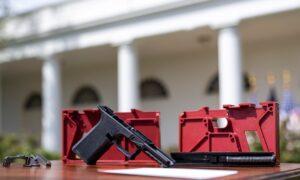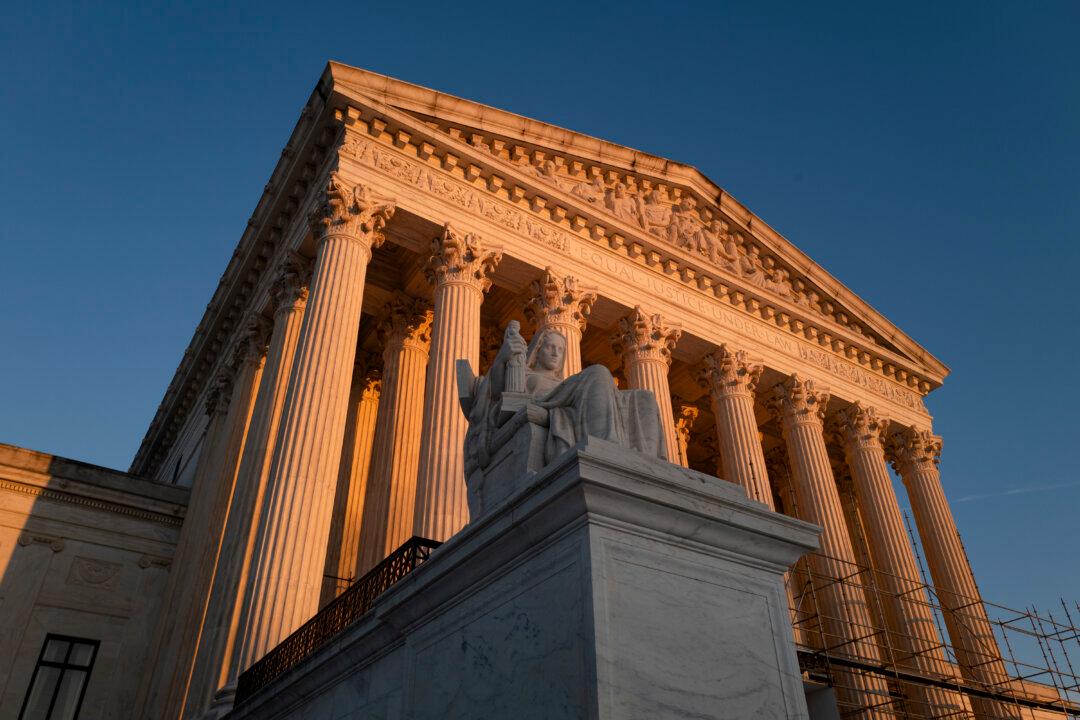The Supreme Court on Oct. 6 stayed a lower court order blocking the Biden administration’s rule regulating so-called ghost guns that can be assembled at home, allowing the policy to remain in force until Oct. 16.
The new order from Justice Samuel Alito came late in the day on Oct. 6 in an emergency application, in a case known as Garland v. Blackhawk Manufacturing Group Inc. (court file 23A302). U.S. Attorney General Merrick Garland filed the application on behalf of the Biden administration.
The lower court order is now administratively stayed until 5 p.m. on Oct. 16.
“Ghost gun” is a pejorative term used by gun control advocates to describe a homemade firearm that lacks a serial number and therefore can’t be tracked by law enforcement. Although some states regulate homemade guns, gun control groups have been trying for years to ban or regulate homemade guns at the federal level but have failed to convince Congress to act.
President Joe Biden has claimed that privately made guns, which are often made with gun kits, are the “weapons of choice for many criminals.”
The government’s “frame or receiver” rule dates to April 2022. It requires individuals who assemble homemade firearms to add serial numbers to them. The rule also mandates background checks for consumers who buy gun-assembly kits from dealers.
Pieces of guns that are shipped are nonetheless still guns subject to existing laws, the government argues.
‘Unlawful Agency Action’
On July 5, U.S. Judge Reed O’Connor of the U.S. District Court for the Northern District of Texas issued an injunction after finding that the regulation violated existing law.Judge O’Connor found that the Bureau of Alcohol, Tobacco, Firearms, and Explosives (ATF), which is part of the U.S. Department of Justice (DOJ), went beyond its statutory jurisdiction in regulating “partially manufactured firearm components, related firearm products, and other tools and materials.”
The rule “is unlawful agency action,” the judge found at that time.
On July 24, the 5th Circuit denied the government’s request to stay the lower court’s order blocking the rule “because the ATF has not demonstrated a strong likelihood of success on the merits, nor irreparable harm in the absence of a stay.”
The issue came before the Supreme Court on Aug. 8 when a 5–4 split on the high court allowed the government’s rule on ghost guns to remain in place while an appeal of the injunction proceeded in the 5th Circuit.

Four conservative justices—Clarence Thomas, Samuel Alito, Neil Gorsuch, and Brett Kavanaugh—dissented from the decision.
Two conservatives—Chief Justice John Roberts and Justice Amy Coney Barrett—joined the court’s three liberals—Justices Sonia Sotomayor, Elena Kagan, and Ketanji Brown Jackson—in voting to allow the rule to remain in effect for the time being.
The nation’s highest court left open the possibility that it could grant a petition for certiorari, or review, in the case at some point in the future. This would allow the court to schedule oral arguments in the case. At least four of the nine justices have to vote for certiorari for it to be granted.
The DOJ argued before the 5th Circuit that the district judge was ignoring the Supreme Court’s order.
“There is a meaningful distinction between vacatur (which is a universal remedy) and an injunction that applies only to two named plaintiffs (which is a traditional equitable remedy),” the circuit court judges said.
At the same time, the circuit court found that the injunction “sweeps too broadly.”
“Injunctions that afford relief to non-parties are potentially problematic,“ the court stated. ”And it appears the district court’s injunction sweeps too broadly insofar as it affords relief to non-party customers.”
Nevertheless, the court found that “the party-plaintiff manufacturers would be irreparably harmed by being forced to shut down their companies or by being arrested pending judicial review of the Final Rule.”
Although it vacated the injunction as it applied to gun kit customers, the court stated that it did so based on the Biden administration’s assurances that it “will not enforce the Final Rule against customers who purchase regulated ‘frames or receivers’ and who are otherwise lawfully entitled to purchase firearms.”
The circuit court also suggested that Judge O’Connor could revisit the matter and broaden his injunction should the administration break its promise to not enforce the rule against customers.
“Of course, if circumstances change, the district court is free to narrowly tailor injunctive relief to meet the changed circumstances,” the 5th Circuit stated.
“But as things stand today, the Government is correct that the injunction cannot extend to non-party customers.”
The circuit court added that the plaintiffs who brought the action against the rule are “likely to succeed on the merits because the Final Rule is contrary to law.”
The new Supreme Court order blocks Judge O’Connor’s Sept. 14 injunction.
The order states that the gun part manufacturers challenging the rule have until 5 p.m. on Oct. 11 to file briefs with the court before it acts on or before Oct. 16, the day the new stay expires.
DOJ officials and counsel for the gun part companies didn’t respond by press time to a request by The Epoch Times for comment.







